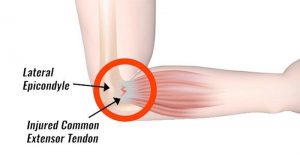
1. It is an overuse injury.
2. Pain is located over the lateral epicondyle which is the bony part of the elbow located on the outer side.
3. Any activity that requires wrist extension will hurt; such as picking up a cup of coffee or shaking someone’s hand.
4. The elbow may feel stiff in the morning.
5. X-rays will not show the pathology. MRI scans will reveal inflammation, partial tears or complete tears of the common extensor tendon.
6. Treatment involves wearing a tennis elbow band 24/7 except for personal care for 6 weeks. The band should be placed two fingers breath below the bone where the pain is located.
7. Click here for tennis elbow stretches.
8. NSAIDS or a topical anti-inflammatory cream can help.
9. If the above fails then a PRP or cortisone injection is an option.
10. If the injections fail, an MRI scan is obtained, and based on the MRI findings surgery may be indicated.
Five Facts You Need to Know About Tennis Elbow If You Are a Tennis Player
1. It is typically a technique problem. How many times have you seen a pro player wearing a tennis elbow band? (Almost never)… It tends to occur from hitting the ball late. Talk to your tennis pro to see if they can pick up on a technique error that can be corrected.
2. Racquet modifications required. Purchase a more flexible racquet. Many racquets that are on the market today are very powerful and stiff. The stiff racquet transmits the force of the ball up the racquet into your elbow. Purchase a more flexible raquet. Talk to your local tennis pro or a store that sells tennis racquets. Many of the internet stores will have consultants you can talk to over the phone to help guide you in racquet selection.
3. Check your strings. You should be using a blended string that is more forgiving. Stay away from the monofilament strings. Your tennis professional will know what to recommend. Consider using a higher gauge string like 16 or 17.
4. Restring your racquet at 2-4 pounds less than what it is currently strung. That will help to decrease the stress on the common extensor tendon.
5. Over wrap your grip by one or two layers. The larger grip will decrease the force on the common extensor tendon when you squeeze the racquet.
For more information on treating tennis elbow, contact Stacie Grossfeld and the Orthopaedic Specialists at 502-212-2663.

Recent Comments